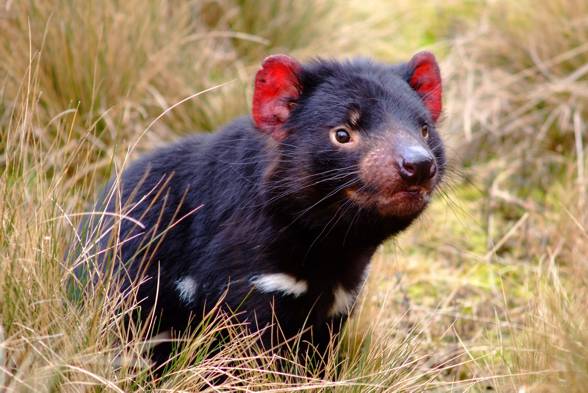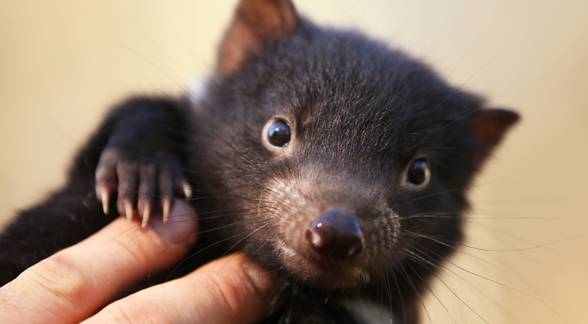Tasmanian devil – the aggressive marsupial
The Tasmanian devil (Sarcophilus harrisii)
The Tasmanian devil is associated with the character of the cartoon for most of us. In real life, this animal is as indomitable as its cartoon counterpart. One individual can kill even 60 pieces of the poultry during only two nights.
Classification:
- Kingdom: Animalia
- Phylum: Chordata
- Class: Mammalia
- Infraclass: Marsupialia
- Order: Dasyuromorphia
- Family: Dasyuridae
- Genus: Sarcophilus
- Species: Sarcophilus harrisii

Distribution
The Tasmanian devil exists only on the area of Tasmania and the Robbins Island, which is joined with Tasmania during the low tide. The north-western population exists on the west of the Forth River and on the south till the Macquarie Harbour.
A few hundred years ago, Tasmanian devils also lived on the area of Australia. They were probably ousted by the dingos, which reproduce faster.

The natural habitat
Tasmanian devils prefer being surrounded by dense and dry forests. They are often seen by roads where they pick up dead animals run over by drivers. They often die in the same way. In Tasmania road signs, which warn about the possibility of the Tasmanian devil appearing on the road, are very common.

Characteristic features
The Tasmanian devil is the biggest living carnivorous marsupial. It has strong squat built and a disproportionately big head as well as a long tail, which is half-length of its body. The fat is accumulated there and therefore, healthy species have very fat tails. Untypically for marsupials, the Tasmanian devil has a little bit longer hind legs, which let it run with the speed of 13 km per hour (8.1 mph) for short distances.
Tasmanian devils’ forelegs have five long toes at the end – four pointing to the front and the one coming out from the side. Thanks to it, they can hold food. Hind feet have four toes with non – retractable claws.

The Tasmanian devil has very strong jaws whose built resemble those of hyena’s. It has prominent canines, four pairs of upper incisors and three lower ones. It can open its jaws to even 75 -80 degrees which lets it generate a lot of power, thanks to which it can tear the meat off and crush bones. The bite of the Tasmanian devil’s jaws is even 553 N.
Tasmanian devils have very long whiskers, which facilitate them to be area-oriented and locate the prey – especially at night. Because these animals forage after the dusk, they see better in the taints of black and white. It lets them react to the movement in a better way but they have a problem seeing still objects clearly. Its most dominant sense is hearing. They also have well-developed olfaction – they recognize smells from the distance of 1 km (0.6 mi).
The Tasmanian devil’s fur is black with the characteristic white patches on its chest. 16% of species do not have any fair patches on their body.
The stink, the obstinateness and characteristic sounds
The scared Tasmanian devil extracts a very unpleasant smell around it. It also gives out very loud bawls and while eating, it is extremely obstinate. The assigned name reveals all its features just like the cartoon, which presents the animal in an exaggerated way.

Behavior
Tasmanian devils are active at night and at daytime, they hide in dense vegetation or in burrows. It is speculated that these animals are nocturnal to avoid predators – mainly eagles and people.
Young Tasmanian devils can climb trees very well but this ability disappears with the age. It is probably the result of the adaptation to the environment conditions. There have been the examples of cannibalism among these Tasmanian animals – adult species can even eat their young when they are very hungry. The young can hide in trees then.
It is thought that Tasmanian devils rather lead the solitary lifestyle but not in the same way as other animals. Most species are the part of a very big network of contacts, which include not only relations the male – the female in the mating period but also those concerning species of the same gender.

Diet
Tasmanian devils are extremely aggressive predators. Its prey can be the animal, which is even the size of a small kangaroo. However, these animals more often behave as opportunists, and instead of hunting for the live haul, they choose the carcass.
Tasmanian devil’s favorite food is the wombat, mainly because of a large amount of fat it contains. The predator also eagerly eats domestic mammals, birds, fish, fruit, insects, frogs, tadpoles and reptiles. Its diet mostly depends on available food.
Tasmanian devils have a very big appetite. During one day, they can consume food, which equals their body weight.

Reproduction
The Tasmanian devil is not the monogamous animal and females usually have a few partners while mating. They choose them among dominating males, which fight for females during the rutting season.
The pregnancy lasts 21 days, and there are from 2 to even 30 young animals born which weigh around 24 g (0.0085 oz). The young stay in the pouch for the next 100 days. However, the female has only four teats, which causes that the competition among the young is very high. The young leaving the pouch are 200 g (7.1 oz). They look like younger copies of their parents. They leave the burrow, which keeps them safe after 3 months.
The average lifetime of the Tasmanian devil is 6 years.

The mysterious tumour disease
Tasmanian devils are in the center of scientists’ interest. In 1996, they became attacked by the mysterious facial tumour disease, which was infectious. Because of that, the species became endangered. The predatory character of animals is favorable for the spread of the disease. Most species exposed to the disease are those attacking other devils.
The disease has even caused changes in the reproduction of Tasmanian devils – there were much younger females taking part in the mating to bring up the young before dying.

Detailed information / size
The Tasmanian devil (Sarcophilus harrisii)
The gender dimorphism can be noticed at Tasmanian devils – males are bigger than females.
- The length of the body:
- males – 65,2 cm (25.7 in)
- females – 57 cm (22 in)
- The length of the tail:
- males – 25,8 cm (10.2 in)
- females – 24,4 cm (9.6 in)
- Weight:
- males on average – 8 kg (18 lb). The biggest males are up to 11kg (24 lb).
- females on average – 6 kg (13 lb).
- Devils in western Tasmania tend to be smaller.
- Lifetime: 6 years
The Tasmanian devil – curios
- The name ‘Tasmanian devil’ is derived from the aggressive character of the animal as well as from the sound given out by it.
- The Tasmanian devil is an endangered species.
- The Tasmanian devil has been ousted from Australia by the dingos.



















